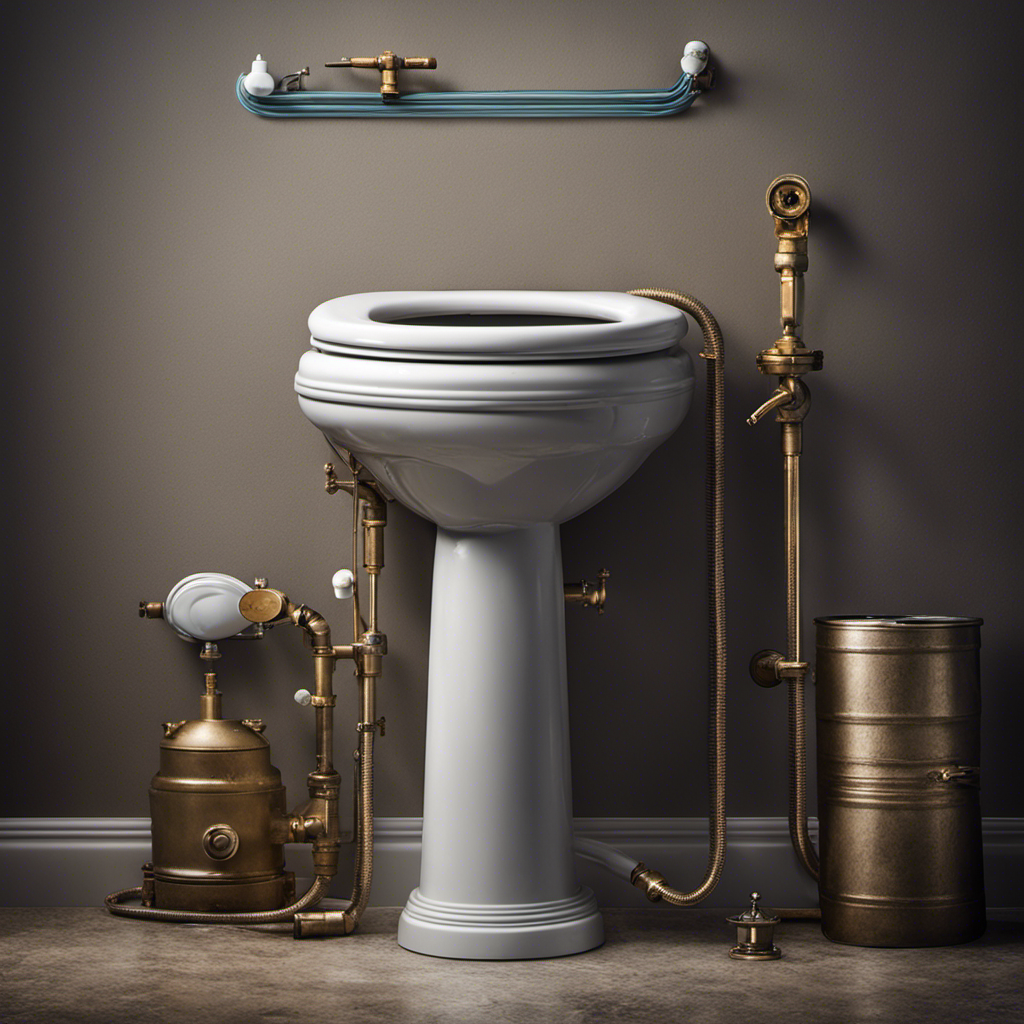Are you tired of being startled by that annoying high-pitched noise coming from your toilet? Well, fret no more! In this article, we will guide you through the possible causes of this pesky problem and provide you with effective troubleshooting solutions.
From understanding the water supply system to evaluating the fill valve and flush valve, we’ve got you covered.
Say goodbye to the noisy toilet and hello to peace and tranquility in your bathroom.
Key Takeaways
- Possible causes of high pitched noise in a toilet when not in use include faulty fill valve, loose or damaged flapper valve, malfunctioning ballcock valve, and worn or damaged parts.
- Troubleshooting the fill valve involves checking for obstructions or debris, cleaning the fill valve cap, inspecting the water supply line for kinks or leaks, and considering installing a water hammer arrestor.
- Evaluating and repairing the flush valve may be necessary if it is damaged and causing incomplete or weak flushes. This can be done by replacing the damaged flush valve and checking for cracks or damage in the toilet handle and tank.
- Water pressure issues, such as clogged pipes, faulty pressure regulators, and water hammer, can also contribute to high pitched noise in a toilet.
Possible Causes of a High Pitched Noise From a Toilet
There are several possible causes for a high pitched noise coming from a toilet when it is not in use.
One common cause is a faulty fill valve. The fill valve is responsible for refilling the toilet tank after each flush. If it becomes worn or damaged, it can create a high pitched noise as it struggles to regulate the water flow.
Another potential cause is a loose or damaged flapper valve. The flapper valve controls the release of water from the tank into the bowl. If it is not sealing properly, it can cause vibrations and a high pitched noise.
Additionally, a malfunctioning ballcock valve, which controls the water level in the tank, can also be a culprit.
To fix toilet noise, it is recommended to replace any faulty valves or parts, ensuring a proper seal and smooth water flow.
Understanding the Water Supply System of a Toilet
The water supply system of a toilet can be understood by examining its components. At its core, the system consists of four main parts: the water supply line, the fill valve, the float, and the flush valve. Each of these components plays a crucial role in ensuring proper water flow and maintaining the water level in the toilet tank.
To give you a better understanding, here is a table summarizing the function of each component:
| Component | Function |
|---|---|
| Water supply | Provides a steady flow of water to the toilet tank |
| Fill valve | Controls the inflow of water into the tank |
| Float | Monitors the water level and signals the fill valve |
| Flush valve | Releases water from the tank into the toilet bowl |
Troubleshooting the Toilet’s Fill Valve
When troubleshooting the fill valve, it’s important to check for any obstructions or debris that may be affecting its function.
Start by shutting off the water supply to the toilet and flushing it to empty the tank.
Remove the fill valve cap and inspect it for any buildup or clogs. Use a cloth or brush to clean the cap and ensure it moves freely.
Next, check the water supply line for any kinks or leaks that could be causing the noise. Straighten any kinks and tighten any loose connections.
If the problem persists, consider installing a water hammer arrestor to prevent the noise. These devices absorb the shock caused by water flow and can help eliminate the high-pitched sound.
Following these troubleshooting steps and noise prevention measures should help resolve the issue with your toilet’s fill valve.
Evaluating the Toilet’s Flush Valve for Issues
If you’re experiencing issues with your toilet not flushing properly or noticing a decrease in water pressure, it could be due to a damaged flush valve.
The flush valve is responsible for releasing the water from the tank into the bowl to create a powerful flush. A damaged or faulty flush valve can result in incomplete or weak flushes, as well as reduced water pressure in the toilet bowl.
Damaged Flush Valve
To fix the damaged flush valve causing the high pitched noise, you should replace it with a new one. A damaged flush valve can lead to several issues, including a noisy toilet and water leakage. Before replacing the flush valve, it is essential to identify the problem by examining the toilet handle and the toilet tank for cracks or any signs of damage. If you notice a damaged toilet handle or toilet tank cracks, it is likely that the flush valve is also affected. Replacing the damaged flush valve is a relatively simple process that can be done by following a few steps. Refer to the table below for a step-by-step guide on how to replace the flush valve.
| Step | Instructions |
|---|---|
| 1 | Turn off the water supply to the toilet. |
| 2 | Empty the tank by flushing the toilet. |
| 3 | Disconnect the water supply line from the bottom of the tank. |
| 4 | Unscrew and remove the old flush valve. |
| 5 | Install the new flush valve and reconnect the water supply line. |
Following these steps will help you replace the damaged flush valve and eliminate the high pitched noise coming from your toilet.
Water Pressure Problem?
If your toilet is making a high-pitched noise when not in use, it could be a sign of a water pressure problem. Water pressure regulation is an important aspect of plumbing maintenance that ensures the smooth functioning of your toilet and other fixtures.
Here are a few reasons why you might be experiencing water pressure issues:
- Clogged pipes: Accumulation of debris or mineral deposits can restrict the flow of water, leading to increased pressure and strange noises.
- Faulty pressure regulator: A malfunctioning pressure regulator can result in inconsistent water pressure, causing your toilet to make unusual sounds.
- Water hammer: This occurs when the flow of water is suddenly stopped, causing a loud banging noise.
To address these issues, it is advisable to consult a professional plumber who can assess and regulate the water pressure in your plumbing system.
Checking the Toilet’s Flapper for Malfunctions
When it comes to checking your toilet’s flapper for malfunctions, there are a few key points to keep in mind.
Firstly, you should be aware of the various flapper replacement options available in the market.
Secondly, it’s important to familiarize yourself with the common flapper malfunctions that you may encounter.
Lastly, understanding these two aspects will enable you to effectively diagnose and address any issues with your toilet’s flapper, ensuring proper functioning and preventing water wastage.
Flapper Replacement Options
There are several flapper replacement options available for fixing the high-pitched noise coming from the toilet when it’s not in use. Taking proper care of your toilet’s flapper is essential to maintain its functionality and prevent any unwanted sounds.
Here are some flapper maintenance and installation tips to help you resolve the issue:
-
Rubber Flapper: This is the most common type of flapper and is known for its durability and flexibility. It’s easy to install and provides a reliable seal, reducing the noise significantly.
-
Adjustable Flapper: This flapper allows you to adjust the water level in the toilet tank, which can help eliminate noise caused by excess water. It offers versatility and can be customized based on your specific needs.
-
Silicone Flapper: This type of flapper is resistant to harsh chemicals and provides a tight seal, reducing noise and preventing water leakage.
Common Flapper Malfunctions
One common flapper malfunction that you may experience is a weak seal, which can result in water leakage and potential damage to your bathroom floor. Maintaining your flapper is crucial to prevent such issues and ensure the smooth operation of your toilet.
Regular flapper maintenance involves checking for any signs of wear or damage, such as cracks or deterioration, and replacing it if necessary. Additionally, ensuring that the flapper chain is properly adjusted and not too loose or too tight can also help prevent water leakage and noise.
By taking the time to inspect and maintain your flapper, you can avoid costly repairs and keep your toilet functioning optimally.
Now, let’s move on to resolving common problems with other toilet tank components.
Resolving Common Problems With Toilet Tank Components
To resolve common problems with toilet tank components, you can try adjusting the water level or replacing the flapper.
Adjusting the water level in the tank can help prevent toilet tank leaks and ensure proper flushing. Start by locating the water level adjustment screw on the fill valve. Turn it clockwise to lower the water level or counterclockwise to raise it.
If the flapper is causing issues, replacing it may be necessary. A faulty flapper can result in a running toilet, wasting water and increasing your water bill. To replace the flapper, turn off the water supply, flush the toilet to drain the tank, and remove the old flapper by detaching the chain and unscrewing any attachment points.
Install the new flapper by reversing these steps.
Conclusion
In conclusion, when your toilet starts making a high pitched noise when not in use, it’s like having a little bird chirping constantly in your bathroom.
But fear not, for there are simple steps you can take to silence this pesky bird. By understanding the water supply system, troubleshooting the fill valve, evaluating the flush valve, and checking the flapper, you can resolve common problems with your toilet’s components and bring peace back to your bathroom sanctuary.
So go forth, my friend, and conquer the noisy toilet beast!










